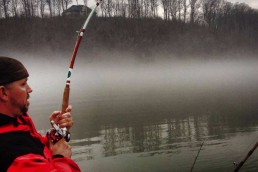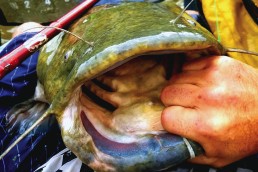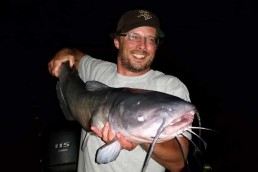Bottoms Up on Big Blue Catfish: Southern Hospitality and the Art of Baiting
SHARE THIS POST
Spending most of my time on the waters up in the North, I know our lakes and reservoirs aren’t as diverse as the South’s fisheries. A big-fish adventure I’ve never gotten to experience up until last month is the pursuit of blue catfish. A recent late-March trip to eastern Tennessee for multi-species treated me to this memorable experience.
Fish of all shapes and sizes fight differently. And catfish are fat, muscular, and laced with power. What I discovered on the gargantuan waters of Watts Bar in Tennessee is that when the largest catfish species, blue catfish, vacuum up the circle-hooked cut bait from 40 feet below, the ensuing battle becomes an exercise, like pumping iron in the gym.
“This fish isn’t helping my sprained shoulder heal from basketball season!” I yelled, to my friends and guides, Matt Lynch and Marc Cooper, as I corralled an average-sized blue catfish into the boat.
It was down deep, and even with our heavy saltwater rods and reels, the experience still felt like hooking into the “Free Willy” of catfish, even as a 25-pounder.
So how much bigger can these species get?
Let these southern boys down here and their hospitality tell you.
Fishing with southern hospitality
“Fighting a blue catfish is like fighting with a bull, at least in terms of the intensity of the conflict,” says Matt Lynch, a Tennessee outdoor writer and part-time fishing guide. “Look at the physical builds of catfish—in Watts Bar they’re the hulking titans of the river and their bodies are one big muscle. When a blue catfish is feeding, nothing stands in its way.”
A blue catfish is like an M1 Abrams tank of the deep, adds Cooper.
“Hook into one and you’ll see what I’m talking about.”
Cooper and Lynch are passionately driven by these monster catfish. As I witnessed in their approach, their obsessions and angling styles parallel and complement each other. With Cooper’s expertise in electronics, and Lynch’s precision baiting techniques, together they form a bright, dynamic duo that has caught and released over 400 pounds of blues in a single day.
Founder of the Collegiate Catfishing Association, a growing national fishing organization, and president of the University of Tennessee Catfishing Club, Cooper takes pride in helping anglers like me catch the largest catfish of their lives.
On this day, his mission was accomplished.
With the potential to surpass weights of 100 pounds, blue catfish are North America’s largest catfish species. The Tennessee state record stands at 112 pounds, and both Lynch and Cooper have obsessive aspirations to someday break it.
Watts Bar
Situated in the heart of the Tennessee River Valley, Watts Bar reservoir encompasses 39,000 acres and is rich in deep rock, ledge habitat and abundant forage species to support a thriving fishery. These waters aren’t heavily pressured, and blue catfish are the kings of Kingston, Tenn.
Cooper and Lynch have helped anglers and their guests catch several personal bests, with specimens surpassing 65 pounds. However, what drives them most is the realistic chance at wrangling with a historic 100-pounder and continuing to break their own personal records.
“Fishing Watts Bar on a good day will leave anglers at a loss, like when Cooper and I hauled in an epic 420 pounds of catfish in mid-March,” Lynch said.
Staggering numbers and a large average size of adult fish at 25 to 50 pounds sets this southern reservoir above all others.
“Looking back, we wrecked the fishery!” he says, laughing.
Watts Bar has shown both anglers its glory and potential. They say on a bad day you can still catch 100 pounds of fish.
Beating the blues
Blue catfish can be sought after any time of the year, but some specific seasonal periods can provide a little more “weight under their belts” Lynch says.
Much of the Watts ecosystem is driven by the output of the Kingston Steam Plant. When it’s generating power an influx of baitfish turns this waterway into prime big-fish feeding grounds. Anglers must also give consideration to the annual shad die-offs too, which allows hungry cats to gorge themselves on another abundant food source. With these two feeding events, Lynch and Cooper favor the late winter through spring period.
Locating the food isn’t the only thing that yields success, as current and flow rates contribute.
Anglers have a realistic chance of catching a giant year ‘round, but the likelihood of that catch varies by season.
“Catfishing success and the Tennessee Valley Authority (TVA) current flows are usually in direct correlation,” Cooper says. “Fish expend energy like humans on a workout regimen and the caloric expenditure requires fish to feed in order to compensate for that. Anglers should follow the TVA release schedule like a stock market broker and his investments,” he quips.
Lynch and Cooper both have a strong personal preference to fishing deeper water and use it as their starting point in locating the larger catfish and they utilize the Buck Perry mentality.
“Blue catfish follow structure like a road map,” Lynch says. “Looking at a key spot means it has to have immediate access to deeper water. A great-looking spot without it will not be productive because without prominent structure they have no road signs to guide them to these locations.”
Copper adds that you can never go wrong with a steep channel breakline, and says main-lake structure relative to deep water is ideal part of the topography to target for trophy catfish.
Are you enjoying this post?
You can be among the first to get the latest info on where to go, what to use and how to use it!
Prior to wetting the lines, Lynch and Cooper spend hours studying topographic maps and their Navionics Platinum chips to determine productive spots and to eliminate dead water.
“Bends in the channel, humps, ledges and channel confluences, current breaks and holes all provide key areas for us,” Lynch said. “It’s all a matter of breaking it down even further when on the water with electronics.”
As fish are in a state of migration, electronics are heavily employed as these two locate schools with a Lowrance HDS unit equipped with down imaging and structure scan. The run-and-gun method with Lynch’s 17-foot Lowe Roughneck with a 30-hp Yamaha jet becomes their preferable tactic and “tool” for seeking active fish. And when they find them the fish will usually still be schooling up. On 2-dimensional screens, blues tend to appear as a bulky arch. When using Lynch’s structure scan the shape of the catfish becomes obvious with its thicker “muscular” shape.
During the spring, blue catfish are still holding deep, but will make short movements into the shallows to feed. Couple this with unpredictable weather and you can see why Lynch and Cooper prefer the deepest waters.
“Not only do we fall back on deep water being the home of big fish, but it offers them stability in the early parts of the season,” Lynch says.
He added that for this reason the deep holes are the fish’s sanctuaries. And when water temperatures rise into the 50s these fish will begin migrating upriver toward the headwaters and smaller rivers to spawn.
They say blues don’t tend to follow a basic migratory spawn movement like most species, but when schools are located, they will be concentrated.
By late spring through summer, Lynch and Cooper turn their attention to river stretches and current seams feeding into the main lake.
“We focus a lot on the tailwater areas of many reservoirs, and drifting can be the most effective technique for covering an endless eastern Tennessee reservoir like Watts Bar because fish will disperse,” Cooper says.
Copper added that throughout summer and into early fall the catfish will still relate to the same forms of structure and cover before a reverse migration takes place in late fall, leading them back to their wintering holes.
The ‘blues brothers’ battle
For most of their catfishing, cut bait is the overwhelming choice. Due to their abundance in the Clinch and Tennessee river systems, skipjack herring is often the best catfish bait when properly prepared.
“Skipjack herring is an inherently bloody, extremely oily fish,” says Cooper, who is a new world- record holder with a 4.28-pound specimen he recently caught.
“They grow to large sizes and are in abundance, which is why they’re a key target for predation,” Lynch adds.
Skipjacks can be caught from any of the local steam plants by ultra-light hook-and-line methods. Lynch and Cooper insist that for best preparation the skipjack must be immediately thrown on ice and vacuum-sealed for freezing. When prepared this way the head and midsections are a tempting bloody mess to cats when rigged properly.
For rigging, Lynch and Cooper put their entire six-rod spread in a Carolina-style fashion with sinker bumpers, slides and 6-to 8-ounces of No Roll bank weights poured by Lynch himself. This package is then attached to a snelled Team Catfish 8/0 circle hook that is presented in both single- and double-hook versions that are dictated by the size of the cut skipjacks.
The guys use a multitude of heavy saltwater gear built to tackle the large fish. For most of their cut-bait fishing they prefer 8-foot Okuma Battle Cat rods.
“New to the market, these have sensitivity and backbone to the handle design,” says Lynch, of these rods.
As for reels, size 300 to 500 Quantum Irons, Abu Garcia Ambassadeurs and Okuma Komodo reels equipped with loud bait clickers and strong drag systems are preferred. Most importantly, the reel they say must also have a huge line capacity to support 50-pound high-vis. Trilene Big Game monofilament.
And rod holders are the quintessential part of a catfish boat they say.
“If anchoring or control-drifting, rod holders are required,” Cooper says.
Lynch’s jet boat features an elaborate custom-welded, removable overhead rod-holder system equipped with Monster Rod Holders that effectively spread out lines and keep them angled perfectly above the surface, and engaged with current.
“I don’t see a lot of people employing the bar setup I use, however, most may not seek catfish with such diligence like us,” Lynch said. “It allows a better rod spread off the stern and allows the bait to work and disperse a scent trail with the current.”
Lynch’s preferred setup is anchoring sets with his Cat River anchors—bow faced into the current—and just kicking back and waiting.
“I watch for any line jiggles and the drags to scream.”
Blue catfish may be bottom-feeders, but their fight is defined with deep, powerful runs and with bone-shaking headshakes. Anglers like Matt and Marc are setting the southern catfish world on fire through their stewardship with conservation, education and exposure and introduction of intricate and artful new age techniques for this species.
And, they’re helping many deprived catfish anglers like me “pop” their first catfish cherries.
MWO
SHARE THIS POST
Did you enjoy this post?
You can be among the first to get the latest info on where to go, what to use and how to use it!
Andrew Ragas
Andrew Ragas splits time between Chicago and Wisconsin’s Northwoods. Based in Minocqua, Wis., he specializes in trophy bass fishing and offers guided trips from May through October. While big bass are his passion, he dabbles in multispecies, as well. He may be visited online at northwoodsbass.com



